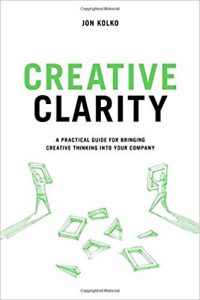By Jon Kolko
 Design strategy is built on assertion. On the way to a great design strategy is the creation of a series of value assertions: driving statements that guide creative exploration and describe our commitment to our customers.
Design strategy is built on assertion. On the way to a great design strategy is the creation of a series of value assertions: driving statements that guide creative exploration and describe our commitment to our customers.
Value assertions create a set of strategic boundaries, framed as promises, and then describe how our company is set up to deliver on those promises. The assertions are developed by:
- Describing customer expectations – the things customers presume a company will do, make, deliver, or present to them.
- Making an assertion of value – the benefits a company promises to deliver to meet or exceed expectations
- Presenting fulfillments – the ways a company will deliver on those expectations
A big, bold value assertion for an educational company might be, “We promise to help minimize anxiety in college students as they make academic decisions.” A value assertion for a digital collaboration company might be, “We promise to help our customers feel a sense of physical community while working remotely from one-another.” And a value assertion for a healthcare software company might be, “We promise to help doctors feel efficient while making data-driven decisions.”
These assertions are promises, and they focus on feelings paired with utility. This is part of a design strategy, and one way it differs from a business strategy is that it emphasizes the styles of emotional experiences we want our customers to have.
I run a design strategy company called Modernist Studio. At Modernist, we recently worked with an organization – call it First Financial – that offers complex financial products. As we collaboratively developed our design strategy, our business partners continued to focus on the things they could do as a company: they could develop new products, better train their sales representatives, and create online tools to help educate the market. But all of these make assumptions about what people want and need. Do they need new products? Are they interested in interacting with sales reps? Are online tools useful?
We re-framed the way they thought about their customer/product interactions by grounding thinking in user research, a common approach for justifying design recommendations. Our research with customers showed that they were interested in learning about the financial products, but only on their own terms and schedule, and in a unique way: they wanted to develop a big picture understanding of the financial landscape and the language used to describe the various financial products, and then they would go dormant for a few weeks. Then, they would revisit the information and get a little more detailed, learning new terminology. Then, after a few more weeks, they would make a purchasing decision. At each stage in the process, they were looking for a different type of information, and they wanted that information delivered comparable to their pace of exploration. This incremental process was a way for them to feel less overwhelmed. It was a bite-sized way to learn.
Customer Expectations
First, we described customer expectations: “First Financial progressively teaches me about their products and services on my terms and in language I understand.” This statement describes what a person expects a company to do. It’s concise and direct – it’s focused, in this case, on education (not on purchasing, customer service, onboarding, or any other key business activity; just on education). And it’s written from the perspective of the customer, not from the company. By articulating a single sentence of expectation, we’ve ranked and judged customer needs and identified the most important thing.
This framing of customer expectations is built on a synthesis of our research. Customers say a lot of things during research, and in this case, not all of them focused on education. But the team identified a continuity in this theme, and decided that the continuity was critical in helping customers buy what’s right for them. This was not an overnight prioritization. It came through hours of exploration, debate, and discussion.
Assertion of Value
Next, we simply recast that expectation as an assertion, or a promise: “We promise to progressively teach our customers about our products and services on their terms and in language they understand.” It’s the exact same idea, but written as a commitment. The word “promise” is selected on purpose. This is a big, bold assertion – a promise is a guarantee. If we don’t do this, we’ve failed. And such a bold promise forces us to become pragmatic, quickly, because we now know what we’re signing up for. It needs to be attainable.
This is what’s meant when we talk about a value proposition, but it’s a proposition around how we help customers, not necessarily around the actual products they sell. This statement isn’t about the financial security they’ll get from a financial instrument that First Financial sells – it’s about the promise of their experience navigating through the financial journey.
Fulfillments
Finally, we can create fulfillments, which are ways we’ll deliver on our promise. To make our assertion become real, we’ll need to act in certain ways, do things, and build things. For example, we can fulfill our promise through curation; “We will deliver on our promise by presenting only some of our products, rather all of them.” Or, we can fulfill our promise by using common language, rather than factually correct language; “We will deliver on our promise by sacrificing accuracy in terminology for accessible, colloquial language.”
If we put it all together, the path from expectation, to value, to fulfillment looks like this:
We promise to progressively teach our customers about our products and services on their terms and in language they understand. We will deliver on our promise by…
- Presenting only some of our products, rather all of them
- Sacrificing accuracy in terminology for accessible, colloquial language
- Displaying product facets next to one-another, so they can be compared
- Minimizing the presence and pressure of “buy” calls to action
These are product fulfillments. They can also be service, brand, or organizational fulfillments:
- Speaking consistently across channels with one uniform set of words about our products
- Acting empathetically and with a supportive voice in our call centers
The process of moving from expectation to assertion to fulfillment doesn’t tell us what to build – that comes from creative vision. But the process points at characteristics of how to build it. They add assessment criteria for judging if a design or business decision is a good idea. The assertions and fulfillments are artificial, but once they are articulated, they become firm. We all agree to them, and now we have a common language for understanding what is good and what is bad. And, we have a common framework for gauging if and how we are achieving out value promise – the promise we’ve asserted and committed to.
 Jon Kolko is the author of Creative Clarity, Partner at Modernist Studio, and the Founder of Austin Center for Design. Previously the Vice President of Design at Blackboard, he has worked extensively with both startups and Fortune 500 companies. He has been a Professor of Interaction and Industrial Design at the Savannah College of Art and Design, and has taught at the University of Texas at Austin, the Center for Design Studies of Monterrey, Mexico, and Malmö University, Sweden.
Jon Kolko is the author of Creative Clarity, Partner at Modernist Studio, and the Founder of Austin Center for Design. Previously the Vice President of Design at Blackboard, he has worked extensively with both startups and Fortune 500 companies. He has been a Professor of Interaction and Industrial Design at the Savannah College of Art and Design, and has taught at the University of Texas at Austin, the Center for Design Studies of Monterrey, Mexico, and Malmö University, Sweden.



